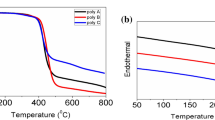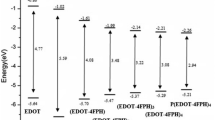Abstract
A low band gap (\(E_\text {g} = 1.6 ~ \text {eV}\)) copolymer, P2TI-DD, with bithiophene donor and 2-decyldodecyl (DD)-substituted isoindigo acceptor was successfully prepared using direct arylation polycondensation method. Its HOMO and LUMO energy levels were found to be \(-5.47\) and \(-3.79 ~ \text {eV}\), respectively. The PL spectra of P2TI-DD in solvents of different polarity were found to red-shift with increasing solvent polarity while its absorption remained the same, confirming the intramolecular charge transfer characteristics of its excited state and non-polar ground state, respectively. The deconvoluted PL spectra of the copolymer confirmed the presence of inter-chain exciton in the poor solvent, cyclohexane and thin films while it is missing in the chlorinated solvents. Thermally induced degradation reduced the absorption of P2TI-DD by 35% after heating at 85 °C for more than 190 h. The main degradation mechanism in the copolymer was found to be chain scission as confirmed by the increase in the free exciton bandwidth and the appearance of a blue-shifted emission. The thermal decomposition temperature of P2TI-D was around 330 °C. Its X-ray diffraction traces revealed a sharp peak which corresponds to ordered lamellar (100) planes and a broad halo (010) due to the characteristics of π–π interchain stacking in the films.









Similar content being viewed by others
References
B. Du, R. Geng, W. Tan, Y. Mao, D. Li, X. Zhang, D. Liu, W. Tang, W. Huang, T. Wang, Heating induced aggregation in non-fullerene organic solar cells towards high performance. J. Energy Chem. 54, 131–137 (2021)
Q. Liu, Y. Jiang, K. Jin, J. Qin, X. Jingui, W. Li, J. Xiong, J. Liu, Z. Xiao, K. Sun et al., 18% efficiency organic solar cells. Sci. Bull. 65(4), 272–275 (2020)
Y. Cui, H. Yao, J. Zhang, K. Xian, T. Zhang, L. Hong, Y. Wang, X. Ye, K. Ma, C. An et al., Single-junction organic photovoltaic cells with approaching 18% efficiency. Adv. Mater. 32(19), 1908205 (2020)
J. Xiong, K. Jin, Y. Jiang, J. Qin, T. Wang, J. Liu, Q. Liu, H. Peng, X. Li, A. Sun et al., Thiolactone copolymer donor gifts organic solar cells a 16.72% efficiency. Sci. Bull. 64(21), 1573–1576 (2019)
Y.-J. Cheng, S.-H. Yang, C.-S. Hsu, Synthesis of conjugated polymers for organic solar cell applications. Chem. Rev. 109(11), 5868–5923 (2009)
A.V. Patil, W.-H. Lee, E. Lee, K. Kim, I.-N. Kang, S.-H. Lee, Synthesis and photovoltaic properties of a low-band-gap copolymer of dithieno [3, 2-b: 2’, 3’-d] thiophene and dithienylquinoxaline. Macromolecules 44(6), 1238–1241 (2011)
J.D. Yuen, F. Wudl, Strong acceptors in donor-acceptor polymers for high performance thin film transistors. Energy Environ. Sci. 6(2), 392–406 (2013)
J.E. Hyuk, A. Hyungju, J.W. Ho, J.J. Woong, J.J. Woong, Isoindigo-based conjugated polymer for high-performance organic solar cell with a high VOC of 1.06 V as processed from non-halogenated solvent. Dyes Pigment. 161, 113–118 (2019)
L. Song-Fu, C. Chin-Ti, C. Chi-Yang, Isoindigo-dicyanobithiophene-based copolymer for high performance polymer-fullerene solar cells reaching 1.06 V open circuit voltage and 8.36% power conversion efficiency. ACS Macro Lett. 6(9), 969–974 (2017)
C.H. Yeon, P. Jung-Hwa, C. Junjie, K. Su-Yeon, O. Juwon, K. Dongho, P.S. Young, Influence of intramolecular charge-transfer characteristics of excitons on polaron generation at the donor/acceptor interface in polymer solar cells. J. Phys. Chem. C 125(33), 18352–18361 (2021)
T. Keller, T. Gahlmann, T. Riedl, U. Scherf, Direct arylation polycondensation (dap) synthesis of alternating quaterthiophene–benzothiadiazole copolymers for organic solar cell applications. ChemPlusChem 84(9), 1249–1252 (2019)
C. Dan, Q. Shengchun, W. Zhanguo, W. Jizheng, High efficiency P3HT:PCBM solar cells with an inserted PCBM layer. J. Mater. Chem. C 2(22), 4383–4387 (2014)
N.A. Tegegne, Z. Abdissa, W. Mammo, M.R. Andersson, D. Schlettwein, H. Schwoerer, Ultrafast excited state dynamics of a bithiophene–isoindigo copolymer obtained by direct arylation polycondensation and its application in indium tin oxide-free solar cells. J. Polym. Sci., Part B: Polym. Phys. 56(21), 1475–1483 (2018)
ASTM International, Standard Test Methods for Photovoltaic Modules in Cyclic Temperature and Humidity Environments ASTM e1171–15 (ASTM International, West Conshohocken, 2015)
M. Zhiying, G. Hua, W. Dong, S. Zhigang, Influence of alkyl side-chain length on the carrier mobility in organic semiconductors: herringbone vs. pi-pi stacking. J. Mater. Chem. C 4(20), 4546–4555 (2016)
F.C. Spano, C. Silva, H-and J-aggregate behavior in polymeric semiconductors. Annu. Rev. Phys. Chem. 65, 477–500 (2014)
Y. Yan, Y. Bohao, Y. Yongjie, Z. Hailiang, Novel side-chain alternative copolymer combined FRET and DRET with large pseudo-Stokes shift and polarity-sensitive fluorescence behavior. J. Mater. Chem. C 7(36), 11285–11292 (2019)
A. Tegegne Newayemedhin, A. Zelalem, M. Wendimagegn, U. Takayuki, O.-S. Yoshiko, G. Francesco, P. William, R. Andersson Mats, S. Derck, V. Varun et al., Effect of alkyl side chain length on intra-and intermolecular interactions of terthiophene–isoindigo copolymers. J. Phys. Chem. C 124(18), 9644–9655 (2020)
Z.E. Lampert, C.L. Reynolds Jr., J.M. Papanikolas, M. Osama Aboelfotoh, Controlling morphology and chain aggregation in semiconducting conjugated polymers: the role of solvent on optical gain in meh-ppv. J. Phys. Chem. B 116(42), 12835–12841 (2012)
N.A. Tegegne, Z. Abdissa, W. Mammo, Photophysical, thermal and structural properties of thiophene and benzodithiophene-based copolymers synthesized by direct arylation polycondensation method. Polymers 13(7), 1151 (2021)
M.G. Tessema, A. Newayemedhin, Correlation between LUMO offset of donor/acceptor molecules to an open circuit voltage in bulk heterojunction solar cell. Phys B Condens. Matter 445, 56–59 (2014)
Z. Ma, E. Wang, M.E. Jarvid, P. Henriksson, O. Inganäs, F. Zhang, M.R. Andersson, Synthesis and characterization of benzodithiophene–isoindigo polymers for solar cells. J. Mater. Chem. 22(5), 2306–2314 (2012)
C. Jenny, S. Carlos, H. Friend Richard, C. Spano Frank, Role of intermolecular coupling in the photophysics of disordered organic semiconductors: aggregate emission in regioregular polythiophene. Phys. Rev. Lett. 98(20), 206406 (2007)
C. Jenny, C. Jui-Fen, C. Spano Frank, H. Friend Richard, S. Carlos, Determining exciton bandwidth and film microstructure in polythiophene films using linear absorption spectroscopy. Appl. Phys. Lett. 94(16), 117 (2009)
N.A. Tegegne, Aggregation and thermally induced photo-physics and structural ordering of thiophene–quinoxaline copolymer. Mater. Res. Express 8(9), 095307 (2021)
M.L. Raicoski, M.G. Vivas, Photobleaching kinetics of meh-ppv in solution: the role of conformational disorder. J. Phys. Chem. B 125(34), 9887–9894 (2021)
M. Manceau, A. Rivaton, J.-L. Gardette, S. Guillerez, N. Lemaître, The mechanism of photo-and thermooxidation of poly (3-hexylthiophene)(p3ht) reconsidered. Polym. Degrad. Stab. 94(6), 898–907 (2009)
H.F. Dam, T.R. Andersen, M.V. Madsen, T.K. Mortensen, M.F. Pedersen, U. Nielsen, F.C. Krebs, Roll and roll-to-roll process scaling through development of a compact flexo unit for printing of back electrodes. Solar Energy Mater. Solar Cells 140, 187–192 (2015)
B.S. Desalegn, N. Bekri, F.G. Hone, D.M. Andoshe, W. Mammo, Z. Abdissa, G. Bosman, N.A. Tegegne, One-pot synthesis and thermal stability of thiophene-bridged thieno [3, 2-b] thiophene donor-based copolymers. Mater. Today Commun. 29, 102803 (2021)
L. Fernandes, H. Gaspar, J.P.C. Tomé, F. Figueira, G. Bernardo, Thermal stability of low-bandgap copolymers ptb7 and ptb7-th and their bulk heterojunction composites. Polym. Bull. 75(2), 515–532 (2018)
Funding
NB, ZA and WM would like to acknowledge the financial support from the International Science Program (ISP), Uppsala Univeristy, Sweden. NT would like to acknowledge the financial support from Organization for Women in Science for the Developing World (OWSD).
Author information
Authors and Affiliations
Corresponding author
Ethics declarations
Conflict of interest
The authors declare that they have no known conflict of interest in the work.
Additional information
Publisher's Note
Springer Nature remains neutral with regard to jurisdictional claims in published maps and institutional affiliations.
Supporting Information
Below is the link to the electronic supplementary material.
10854_2022_8499_MOESM1_ESM.docx
Details of materials used, molecular weight determination, and PL of P2TI-DD in solution and DFT results such as the optimized geometry and ESP of the mono-and di-mer are included. Supplementary file1 (DOCX 1179 kb)
Rights and permissions
About this article
Cite this article
Bekri, N., Asmare, E., Abdissa, Z. et al. Photophysics and thermally-induced degradation of P2TI-DD, a polymer synthesized by direct arylation reaction. J Mater Sci: Mater Electron 33, 16066–16076 (2022). https://doi.org/10.1007/s10854-022-08499-w
Received:
Accepted:
Published:
Issue Date:
DOI: https://doi.org/10.1007/s10854-022-08499-w




